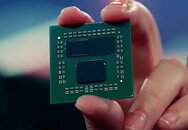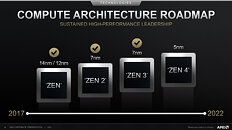
AMD Ryzen Threadripper Pro 5945WX and 5995WX Surface
AMD is looking to launch a substantial lineup of HEDT and workstation processors before the end of 2021, based on its latest "Zen 3" microarchitecture. These processors are categorized in two distinct lines—the Ryzen Threadripper 5000X targeting HEDTs, and the Ryzen Threadripper Pro 5000WX targeting workstations. Both are based on different sockets, sTRX4 and sWRX8, respectively, with the latter featuring 8-channel DDR4 memory, compared to the former's 4-channel. Two Ryzen Threadripper Pro 5000WX series chips surfaced on the Milky Way@Home distributed computing database, the 5945WX and 5995WX.
The application identifies the 5945WX as a 12-core/24-thread processor, while the 5995WX is the top-dog 64-core/128-thread part. AMD maintains lower core-count Threadrippers to target the section of the market that seeks I/O capabilities over core-counts (memory bandwidth, a large number of PCIe lanes supporting NVMe RAID or multiple AIC compute accelerators, etc,). The lower core counts also come with higher CPU clock-speeds, benefiting less-parallelized applications. At this point it's not known if the Threadripper 5000 family features the conventional "Zen 3" CCD chiplet, or the new "Zen 3+" chiplets with 64 MB 3D Vertical Cache (3DV cache), but the company is planning to monetize the new chiplet across its EPYC enterprise line as the additional cache benefits certain applications with large streaming data-sets. It's conceivable that the Threadripper Pro series could benefit from 3DV cache, too.
The application identifies the 5945WX as a 12-core/24-thread processor, while the 5995WX is the top-dog 64-core/128-thread part. AMD maintains lower core-count Threadrippers to target the section of the market that seeks I/O capabilities over core-counts (memory bandwidth, a large number of PCIe lanes supporting NVMe RAID or multiple AIC compute accelerators, etc,). The lower core counts also come with higher CPU clock-speeds, benefiting less-parallelized applications. At this point it's not known if the Threadripper 5000 family features the conventional "Zen 3" CCD chiplet, or the new "Zen 3+" chiplets with 64 MB 3D Vertical Cache (3DV cache), but the company is planning to monetize the new chiplet across its EPYC enterprise line as the additional cache benefits certain applications with large streaming data-sets. It's conceivable that the Threadripper Pro series could benefit from 3DV cache, too.









